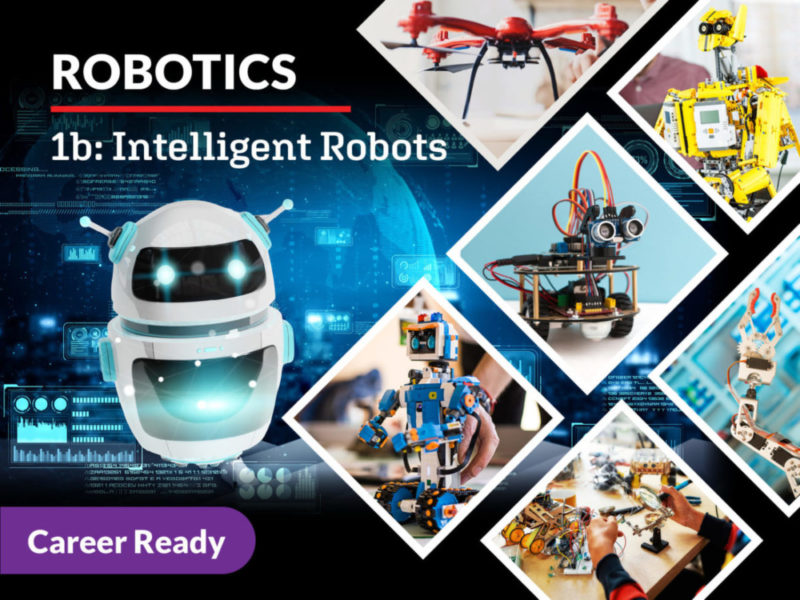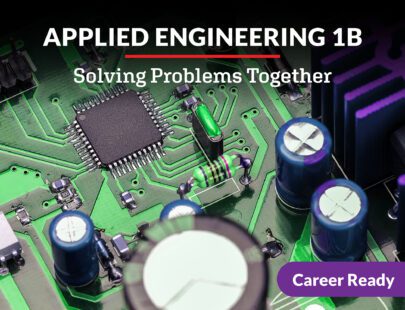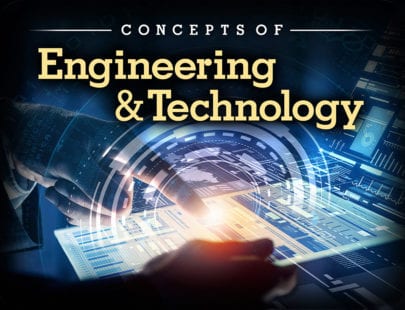
Robotics 1b: Intelligent Robots
The robots have invaded… and they’re here to make our lives easier. You’ve learned about the basics of robotics and STEM careers, but now we’re going to learn about manipulating the physical world to create desired effects. In this course, you’ll learn to manipulate electrical signals to create logic and memory, how to quantify the physical world through variables, and how to have an impact through tools. You’ll discover how to choose the best tools and materials, how to create AI, and how to take an idea from initial planning to a completed project. Let’s continue the pursuit of a career in robotics so the friendly invasion can thrive!
Units at a Glance
Unit 1: Power Supplies and Energy Sources
Powering up a robot’s computers, electric motors, sensors, and other auxiliary equipment requires an energy source. Although we would love to incorporate a battery that could last forever or perhaps even a wireless form of endless energy, we have to acknowledge that we continue to live within the realm of physics. So, when a robot is powered by a wall socket, where does that transferred energy come from? If a robot relies on batteries, how is that chemical energy formed? How do we even know how much electrical energy our robotic system requires? In this unit, you will discover that there are constraints and specific design criteria that will guide your understanding of the options and technology available to convert energy into a power supply for robotic systems.
What will you learn in this unit?
- Explain electrical voltage, current, and resistance
- Differentiate between direct current and alternating current
- Calculate an electrical circuit’s current, voltage, resistance, and power using Ohm’s law
- Configure DC power sources in series and in parallel
- Describe generator action
- Identify a variety of circuit protection devices
Unit 2: Tech Systems
In this unit, we’ll look at the brains of automation and robotics—the transistors that regulate signals, the sensors that take in information, and the microcontrollers that tie everything together. We’ll dive into the computer processing needed for robots to understand the world. Then, we’ll learn about the systems a robot uses to follow instructions and how you can give a robot those instructions.
What will you learn in this unit?
- Understand and label the parts of a microcontroller
- Describe modern transistors and their historical importance
- Accomplish a variety of goals using a transistor in a circuit
- Make informed decisions about which hardware a robot will require
- Explain how information flows through open- and closed-loop robotic systems
- Identify various wired and wireless communication systems used in robotics
Unit 3: Robotic Programming
In this unit, we’ll look at what it means to program equipment on both a conceptual level and a practical level. We’ll see that, while there are ways to be closer to the equipment, high-level programming languages make it possible to code a machine while thinking like a human. We’ll see microcontroller programs in action and then dive into the basic vocabulary and grammar—the semantics and syntax—of the programming language of our microcontroller. These will unlock limitless possibilities as we’ll be able to tell a robot to act if something happens as well as while given conditions are true. At the end, we’ll create our first real-world physical effect: making a light blink.
What will you learn in this unit?
- Explain what a program compiler and assembler do
- Communicate with a microcontroller to send and receive data
- Identify and use common programming semantics and syntax
- Understand how a variety of programming loops can affect microcontrollers
- Implement ways to control and organize the flow of data
- Program the digital output of a microcontroller
Unit 4: Sensors and Circuitry
A robot that didn’t interact with the world wouldn’t be much of a robot at all. Even a calculator needs to respond to pushed buttons. Something like a drone needs to respond to buttons, too, but also must keep track of acceleration, elevation, orientation, and more. In short, robots have to be able to sense their environment. In this unit, we’ll discover the many ways physical properties can be identified, measured, and taken in by the microcontroller brains of systems for processing, manipulation, and distribution.
What will you learn in this unit?
- Describe what sensors are and do
- Calculate the output of a voltage divider
- Explain how analog and digital sensors differ
- Program a microcontroller to collect a sensor’s data
- Build series and parallel circuits on a breadboard
- Identify various types of sensors used in robotic and automated systems
Unit 5: Output Systems
With tiny signals from a microcontroller, we can control and automate large and complex systems. This is done with transistors, but as we’ll see, it also can be accomplished with charged wires wrapped around nails (i.e., electromagnets). With that foundation, we can then push alternating and direct current through motors that spin and motors that step. We’ll see how air and fluids can be manipulated to create forces that are powerful enough to punch nails into wood and subtle enough to tighten a screw. Said simply, we’ll discover how all the designs and components we’ve discussed thus far can be used to impact the world.
What will you learn in this unit?
- Incorporate circuit control devices, such as a microcontroller-controlled relay, into robotic designs
- Explain the differences between AC and DC motors
- Manipulate a DC motor’s direction and speed of rotation
- Control servo and stepper motors
- Describe the characteristics of various fluid systems
- Include sound-based output and temperature controls in robotic systems
Unit 6: Tools, Equipment, and Materials
For a moment, take a mental walk through your local hardware store. You probably won’t see robotic sensors and motors, but you will notice many of the tools and most of the materials for developing a prototype. Building a robot requires expertise with a wide variety of hand tools and power tools. You’ll need them to shape materials with cuts and holes. You’ll also walk by all the woods, plastics, and metals that you’ll cut, drill, bend, and fasten to create your prototype. And, of course, there will be the electronic measurement equipment from previous units. In this unit, we’ll learn a little more about the prototyping tools and materials. A deeper understanding of their best uses and characteristics will guide your work. It’ll also make that trip to the hardware store a bit more exciting as, strolling through the aisles, you’ll know the possibilities that all those tools and materials unlock.
What will you learn in this unit?
- Describe a variety of prototyping materials
- Explain how and when to use a variety of drills when prototyping
- Understand the common tools used to make cuts
- Customize materials with electronic tools, glues, and fasteners
- Use materials and tools that are specifically for use with electronics
Unit 7: Artificial Intelligence
What keeps a swarm of bees in formation? What allows a pet animal to know friend from foe? Taking lessons from the biological brain, computer scientists, engineers, and roboticists come together to develop methods of learning for machines. Although not one-size-fits-all, the processing power capacity and computer memory can help determine just how intelligent a machine might be. In this unit, we’ll see how the worlds of human and machine intelligence come together and look at the implications for both technology and society at large.
What will you learn in this unit?
- Explain how human intelligence informs artificial intelligence
- Describe machine learning techniques
- Recommend uses of cloud-based AI systems
- Analyze the benefits and risks of artificial intelligence
Unit 8: To the Drawing Board
From discovering how to manipulate electricity in components to deciding on which saw blade to use when cutting up wood, you’ve come a long way and learned many things. It’s now your turn to brainstorm, design, and build a robotic device or system. But to do so, you’re going to need to know a few more things. Where should you start? What are the ways projects are managed? How do roboticists collaborate? What goes into a prototype? And what do you do once the prototype is ready? In this unit, we will look at some ways to stay organized throughout the process and how we can communicate our findings to others.
What will you learn in this unit?
- Apply project management tools and concepts
- Utilize the engineering design process in a robotics project
- Create a prototype of a robotic machine
- Analyze, test, and refine a prototype
Required Materials
Physical
- Arduino hardware kit ($59.99)*
- Paper and pencil or pen
*Note: There are many different brand names available, with a wide range of pricing.
Software
- Arduino IDE
- Tinkercad (requires login)
- Teachable Machine
- Word processing software
- Presentation software



